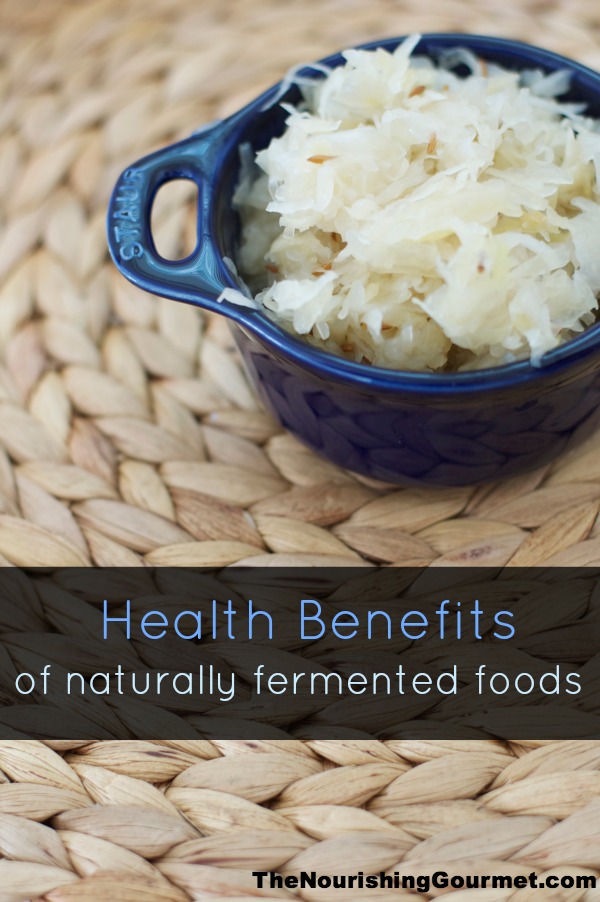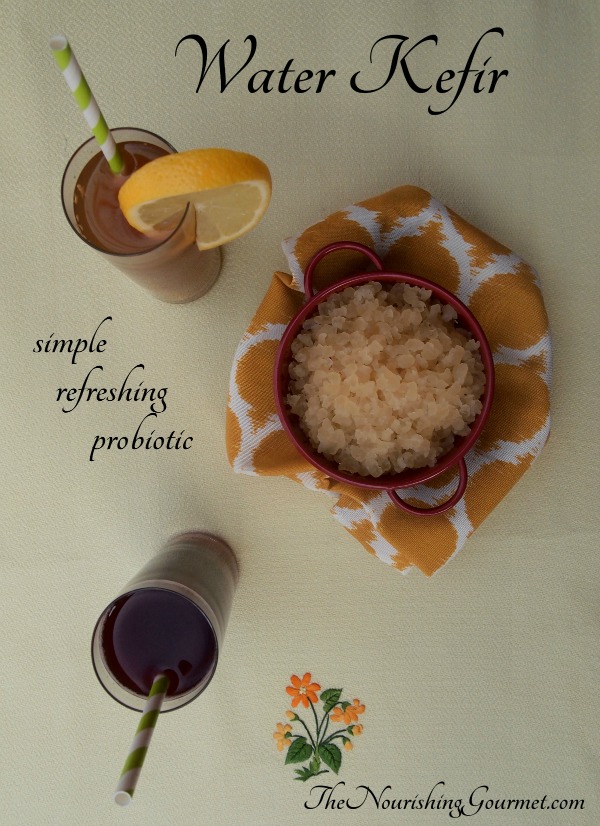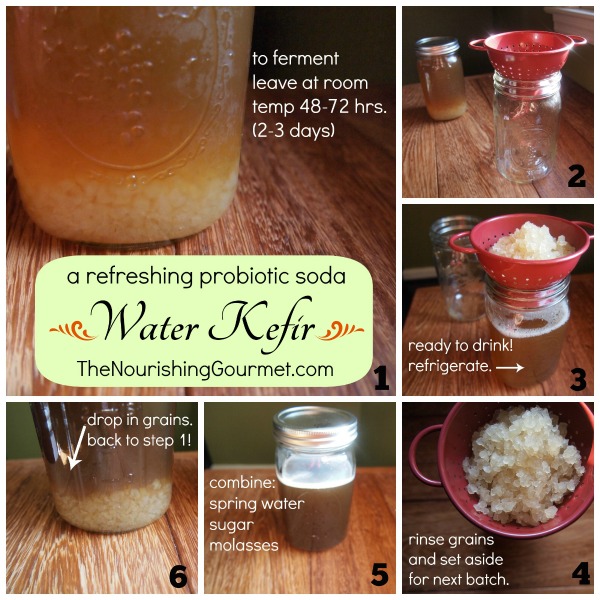
Traditional cultures didn’t have canning jars or supermarkets. The food they harvested in one season often had to be kept for the upcoming seasons, and their survival often depended on its preservation. Thankfully, they had a simple and effective method of preservation – lacto-fermentation. (By the way, lacto-fermentation doesn’t refer to the use of any milk products, but rather to the lactic acid fermentation responsible for culturing.)
Through fermentation, foods are preserved through the work of healthy bacteria. In a process that seems almost magical, but is easily explained through science, yet with roots going back far into history, not only does fermentation preserve food, but it also transforms food into a probiotic supplement and increases digestibility and vitamin content! It’s no wonder that we find fermented foods all over the world in traditional cultures!
There were so many life-changing things I learned from Nourishing Traditions, by Sally Fallon Morrell, and high on the list was learning the value of fermented foods As part of our 21 steps to a nourishing diet series, I wanted to give an introduction to the topic, and give a couple resource suggestions. Look for new, upcoming fermented recipes as well!
Fermented foods are an excellent source of probiotics
While most of our ancestors’ diets would have been brimming with live probiotic bacteria, ours are often devoid. With more and more research showing the importance of a healthy gut, the importance of eating foods that will aid our gut health is becoming more prominent. I personally think that lacto-fermented foods are high on the list of gut-healing foods.
Studies showing health benefits of probiotics
In fact, there are now studies linking specific probiotics to a wide variety of health benefits.
- For example, Bifidobacteria has been linked to decreased cases of neonatal necrotizing enterocolitis.
- Many strains of probiotics have been directly linked to reduced bouts of digestive complaints (including diarrhea).
- Lactobacillus plantarum has been linked to reduced inflammatory bowel, small bowel bacterial overgrowth in children, reduced problems for sufferers of irritable bowel syndrome, and had a positive effect on the immune systems of those suffering from HIV.
- Lactobacillus acidophilus in animal studies has shown a preventative effect for polyps, adenomas, and colon cancer. Source
And those are just a few of the many studies showing benefits!
I personally take probiotics, but I don’t like depending on them solely, as it is believed by some that probiotics in the form of fermented foods are better used by our bodies and are a more effective means to “take probiotics”, if you will. Some studies have zeroed in on specific fermented foods. Sauerkraut, for example, has been shown specifically to be cancer fighting, a digestive aid, and, in one animal study, even a flu fighter! Source
Fermented foods have increased nutritional value
One of the reasons fermented foods are so great is because the fermentation process increases certain nutrients. For example, sauerkraut has an increased vitamin C content. Other traditional fermented food products show a big jump in vitamin content. One example is traditional fermented plant sap ferment by the name of Pulque. During the fermentation process, the thiamine increases from 5 to 29 and the niacin content creases from 54 to 515! All to say, there is a lot of evidence that the fermentation process actually enriches foods with higher amounts of nutrients. Source
Fermented foods are more digestible
I at first assumed that fermented foods were more digestible because of the probiotic content, but that is only part of the benefit! The fermentation process actually makes the food more digestible to us by breaking down hard to digest cellulose in food. This plays an important role in impoverished countries where young infants are fed fermented cereal gruels as a first food. Without the fermentation process, their bodies would have a hard time getting adequate energy from the food. Because so many of us have digestive issues, fermenting our foods could give our bodies a head start in the digestion of our food, while feeding our healthy gut bacteria at the same time.
Fermented foods are safer than raw vegetables to eat
I think that most of us, when first starting to experiment with home ferments, wondered if we were going to do something terribly wrong and kill off our family with the results of our experiments. We just are no longer used to the idea of fermenting things in our home.
But I found it very reassuring that eating fermented foods is safer than eating raw vegetables. The reason is that while yes, raw vegetables can have E.coli on it, once the fermentation process starts, the lactic acid and the E. coli are in direct competition with each other, and lactic acid is a serial killer of E. coli.
Fred Breidt from the USDA’s Food Science Research Unit at North Carolina State University published a paper on this subject specifically in regard to lactic acid fermented cucumbers.
He says, “The presence of live growing cells of lactic acid bacteria, which are the ones that ferment pickles and cheese and a lot of things, actually in competition cause E. coli to die off rather quickly, because they produce things other than just the acid, that’s in the fermented foods. Lactic acid bacteria are highly efficient killers of other bacteria, and they do a marvelous job. This is why vegetable fermentations pretty much always works. It’s been working for thousands of years. It’s one of the oldest technologies known to man and it always works, and the reason is these lactic acid bacteria are very good at what they do, and we take advantage of that as a technology.” Source
While obviously you should follow proper food handling advice and I do think that longer ferments are safest, overall, it appears that you are more at risk getting sick from eating a salad than your lacto-fermented vegetables!
How to make fermented foods practical
I think the most important step to making cultured foods part of your everyday eating lifestyle is to figure out what fermented food is well liked by you (or your family), what is inexpensive enough to eat daily, and what is easy to make. Adding in just one fermented food is a great start, especially if you consume it on a regular basis. Adding in several will help ensure that you are getting the benefits from a wide variety of probiotic sources, as each has its own benefits – but that should be your long term goal, not your first goal.
We have often found it helpful, in really busy times, to simply buy locally made, raw, fermented vegetables. This is hardly the cheapest option, but it has allowed us to continue the practice of eating fermented foods when it was hard to keep my kitchen ferments up and running.
Fermented Vegetable Recipes
- Sauerkraut (this is made using the traditional Russian method also used in the Wild Fermentation book. It’s pretty salty, so you can consider trying to cut down on the salt a little).
- Dilly Carrots
- Lacto-Fermented Roasted Tomato Salsa
- Lacto-Fermented Escabeche
- Indian Kraut
- Lacto-Fermented Garlic
- Lacto-Fermented Cortido
- Mexican Fiesta Cortido
Other Resources:
Why I like Continuous Kombucha Brewing
Books you may find helpful (affiliate links):
Wild Fermentation
The Art of Wild Fermentation
Nourishing Traditions
The Body Ecology Diet

